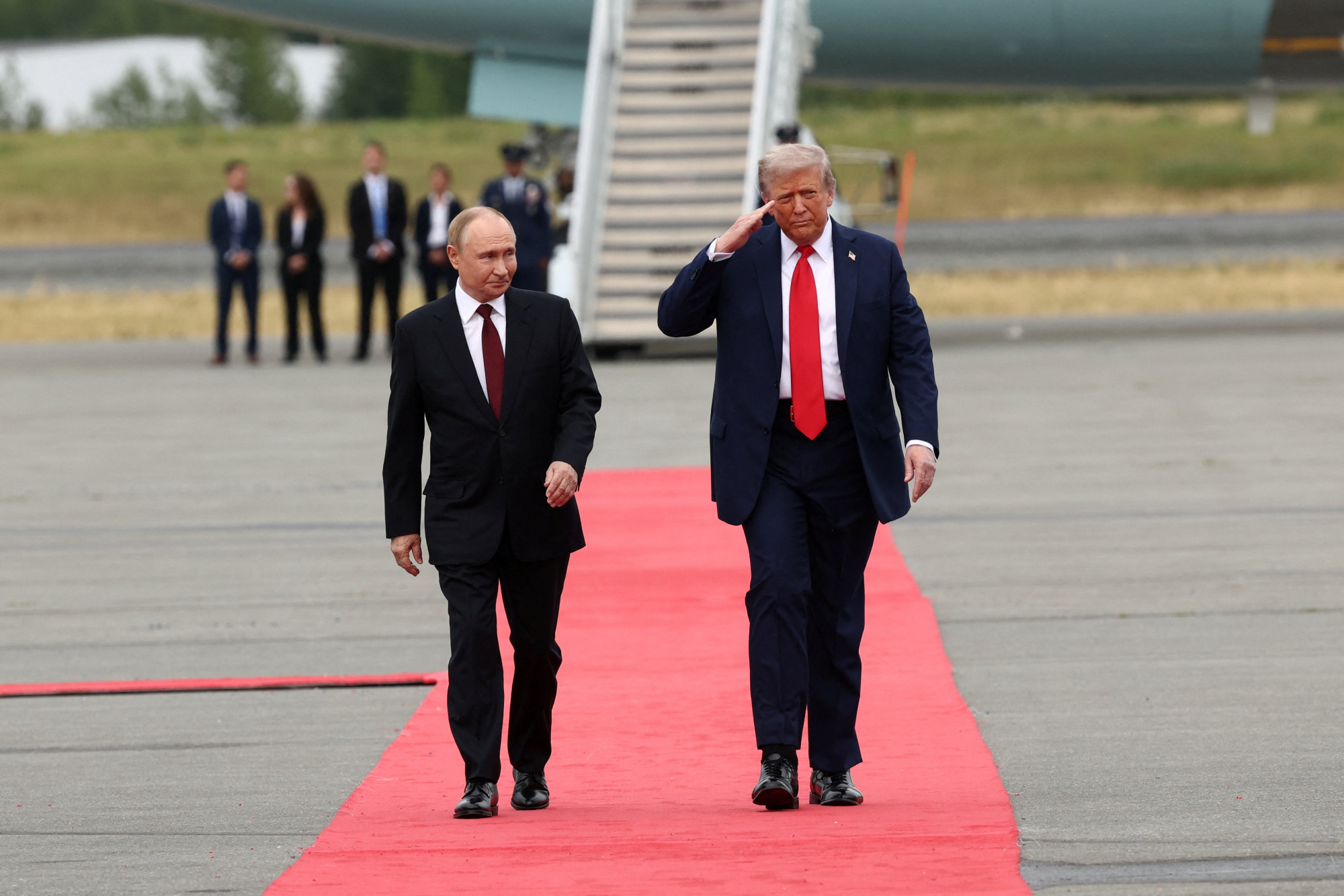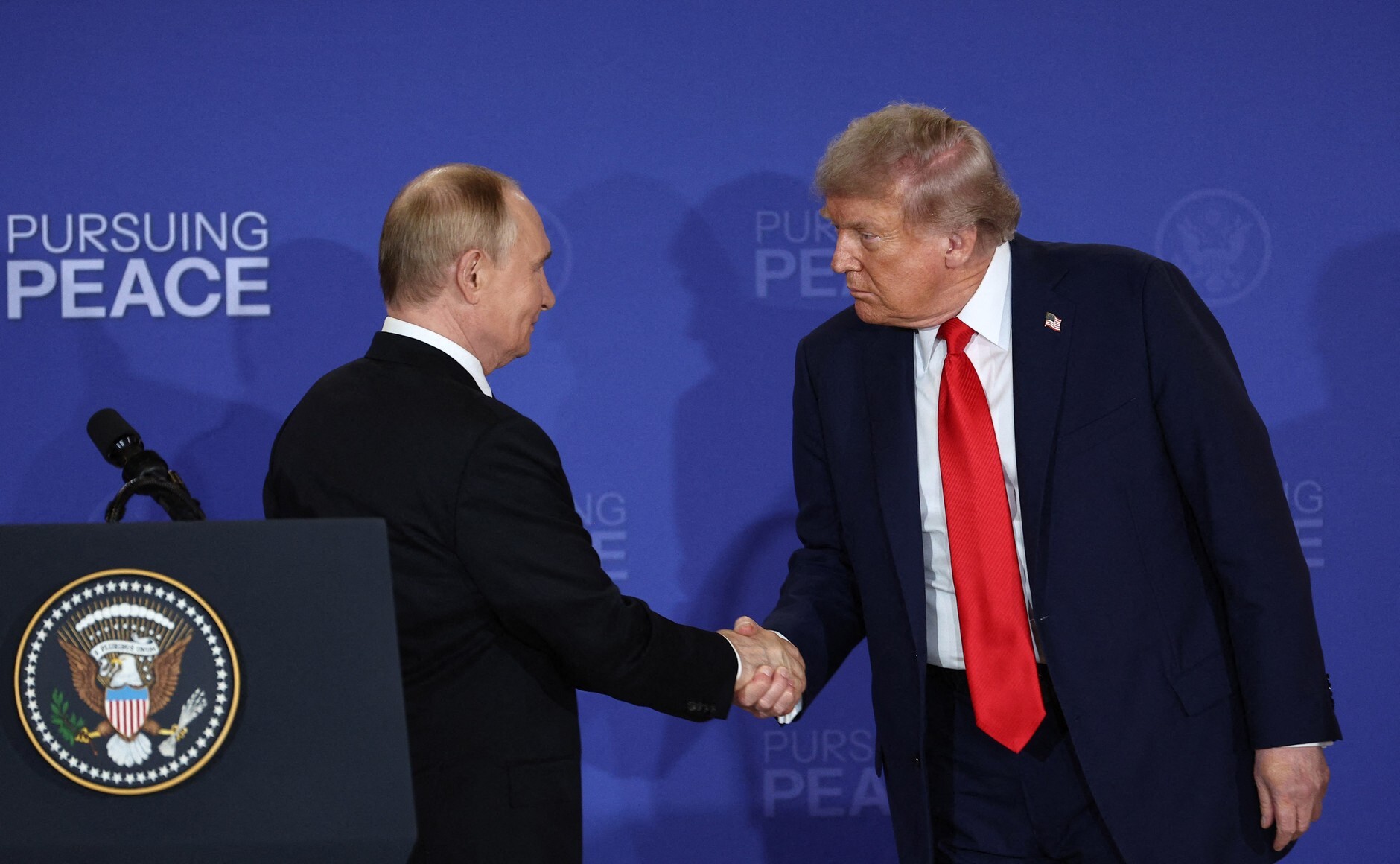Abbreviated program
The main agenda items of the summit changed from the original plans, and were ultimately as follows: a meeting of the two presidents (applause, handshakes, photos, fanfare), a small-scale meeting, a joint Trump-Putin press conference of about 12 minutes (without journalistic questions and the fanfare at the beginning of the meeting), and finally Trump's assessment for Fox News. The planned working lunch and the discussion of the wider delegations were cancelled.
In detail in our introductory material we wrote It is not clear what Trump wants to achieve, and especially how. Putin has so far shown no sign of abandoning his long-term goals in Ukraine. A “Putin peace” would still mean that Ukraine would remain mutilated, subjugated, unable to defend itself, and unable to count on foreign aid, i.e. completely at the mercy of Russia. (Since we currently know practically nothing concrete about what was said at the summit, agreements and disagreements, it is worth re-reading the announcement, where we focused on interests.)
Trump told reporters on his way to Alaska that he wanted to see a quick ceasefire, that he didn’t know if it would happen today, but that he wouldn’t be happy if it didn’t happen today. He repeated his warning that there would be “serious consequences” if Russia refused to stop the fighting, but he didn’t elaborate on what those would be. He also promised to include Ukraine in any decisions that might accompany a more lasting peace process involving territorial concessions, so there was minimal, cautious optimism from the Ukrainian perspective ahead of the summit. That lasted until they saw the red carpet.
Putin was awaited by a red carpet and applause
Trump stood on the red carpet in the United States, once considered the world's gendarme, and applauded the president of Russia, who is accused of war crimes. Although the summit was originally planned to start with a one-on-one meeting between Putin and Trump, they ended up holding smaller meetings, so (most likely) the two presidents only spoke to each other face-to-face in the US president's super-secure limousine, nicknamed the Beast.

The US side of the meeting, which was attended by the president, was represented by Secretary of State Marco Rubio and Middle East Special Envoy Steve Witkoff, while Putin was represented by the CCCP T-shirt He was accompanied by Foreign Minister Sergei Lavrov, who changed into a suit, and Foreign Affairs Advisor Yuri Usakov.

"No deal until there is a deal"
After the meeting, Putin and Trump made their own statements at a brief press conference, but did not answer questions. In a departure from tradition, it was not Trump who took the floor, but Putin who began his remarks. In a veiled pro-war tone towards European leaders, he said he expected Ukraine and its European allies to constructively accept the results of the US-Russian talks and not try to “disturb the progress that is unfolding.”
Trump told reporters that he would brief European leaders and Zelensky on the talks, but added, “There’s no deal until there’s a deal.” It’s telling that Trump, who loves to lecture journalists, didn’t answer questions or ignore the shouting reporters, a rare display of restraint that could really indicate that the meeting didn’t produce anything immediately positive. Trump implied that there was “agreement” on some undisclosed points and not on others, while Putin, even more vaguely, said they had “understandings.” “We had a very productive meeting, we agreed on a lot of things,” Trump said. “There are very few points left open. Some of them are not very significant. One is probably the most important, but we have a good chance of agreeing on that. We haven’t gotten there yet, but there’s a very good chance that we will.” It is not yet known what the controversial topic was. When Fox News host Sean Hannity asked Trump about it, he replied that he did not want to disclose what the controversial topic was,"people will find out sooner or later."
Later, in an interview with Fox, he described the meeting as a “ten” — in the sense that “they got along great.” And Putin played on this in front of the country and the world when, at a press conference, he practically greased the liver of Trump, who often insists that if he had been in office in 2022, the full-scale Russian invasion would never have started. “Today, when President Trump says that if he had been president then, there would have been no war, I am absolutely sure of that. I can confirm it,” Putin said, smiling at Trump. Moreover, according to Trump, Putin also assured him that he also believes the 2020 American election was rigged, since it is impossible to hold an honest election with mail-in ballots.
Trump told Fox News that of the six or seven conflicts he had set out to resolve, this seemed like the easiest task, but he found it to be the most difficult.
It seems that the lack of tangible results has shown the disadvantages of a hastily convened meeting like the one in Alaska. These summits are usually organized when both sides can be reasonably assumed to be inclined to compromise. This was a mistake in Alaska on two counts: Russia still shows no sign of compromise, and the United States, on the one hand, is not as directly involved as Russia in terms of the main issue: this war is being fought by Ukraine, and the Ukrainians, on the other hand, were not invited - primarily at the request of the Russian president. On the other hand, Trump has been sending quite mixed messages lately (he is fed up with Putin's crap/he will impose secondary tariffs on everyone/they will agree on a territorial exchange/all territorial agreements should be decided by the Ukrainians, etc.), and not all of them pointed in the direction of an agreement.
Putin can declare victory from his own perspective
Putin used the press conference to give an impromptu, irritated “history lesson” on the “roots” of the conflict in Ukraine, which he spoke about while standing next to the US president. This was a rather symbolic demonstration of the Russian leader’s continued unwillingness to make concessions, and also highlighted the limits of Trump’s “flattery diplomacy.”
Overall, Friday was a wonderful day for Putin: he stepped out of his now not-so-suffocating international isolation onto the red carpet, B-2 stealth bombers flew over him as a tribute (and not to bomb him), he was able to hop into Trump's armored limousine, where he could laugh face-to-face with the American president and show that the most powerful man in the world welcomes him as an equal, and even applauds him. Then he spoke in front of the entire world press about his meeting with the American president. about understanding . If Putin sees the diplomatic door open while he is achieving military successes in Ukraine, it could encourage further “fact-making” on the battlefield. Even such a vague “understanding” could buy Russia time to continue its territorial gains and tie further negotiations to its own security demands. Putin has made no public pledge to stop his aggression against Ukraine, yet he has been treated as a valued friend. Trump did not blame Putin for starting the brutal war, and he left without mentioning the sanctions he had threatened just hours earlier if a deal was not made. And there was no deal. It is no coincidence that Russian state media has been replaying footage of the red carpet reception almost endlessly, contrasting it with Trump’s treatment of Ukrainian President Volodymyr Zelensky in February, when he simply he/she/it turned out him from the White House.

In our introductory article, we we wrote , for the Russians, these talks are not just about Ukraine. This effort was also evident in Alaska, as Putin brought a number of businessmen with him, despite Trump’s insistence that the meeting would focus on Ukraine. The Russian president had also previously suggested that the talks could include arms control and other issues, which his spokesman said could have been discussed in a six- to seven-hour meeting. Instead, the conversation lasted just over three hours. While Trump expressed appreciation for Putin bringing the businessmen with him despite his recent threat to increase sanctions and other economic penalties, he said: “They want to do business, but they won’t start until we settle the war.”
Trump also flirted with Lukashenko
Putin wasn’t the only dictator Trump rescued from diplomatic isolation on Friday. While en route to Alaska, the president called Belarusian President Alexander Lukashenko. He wrote on social media that he had “a wonderful conversation with the esteemed President of Belarus, Alexander Lukashenko,” and thanked him for releasing 16 prisoners (which the U.S. had little to do with). Trump added that the release of another 1,300 prisoners was also being discussed.
The Belarusian government later said that Lukashenko had invited Trump to Belarus and that the president had accepted the invitation. The White House did not immediately confirm this, but Trump wrote on social media: “I look forward to meeting with President Lukashenko in the future.”
What to expect now?
- Trump promised to speak to NATO and Volodymyr Zelensky and inform them about the meeting, adding that “ultimately it will be up to them.” It is likely that if he informs the allies about the issues on which they agreed with Putin and what the differences were, the press will eventually get more information.
- Putin invited Trump to Moscow for the next meeting, but Trump did not immediately say yes.
- The next step could be a three-way Trump-Zelensky-Putin meeting, but we haven’t heard much about that possibility either. Trump mused on Fox News about a three-way summit between him, Zelensky, and Putin, but added, “I haven’t asked (Putin) about it.” Twenty minutes later, however, he said he had discussed it with Putin: “They both want me to be there. And I’ll be there.”
- The war in Ukraine continues. Putin probably just wanted to offer Trump enough time to continue advancing Russian forces in eastern Ukraine, where they have made a major breakthrough in recent weeks.

